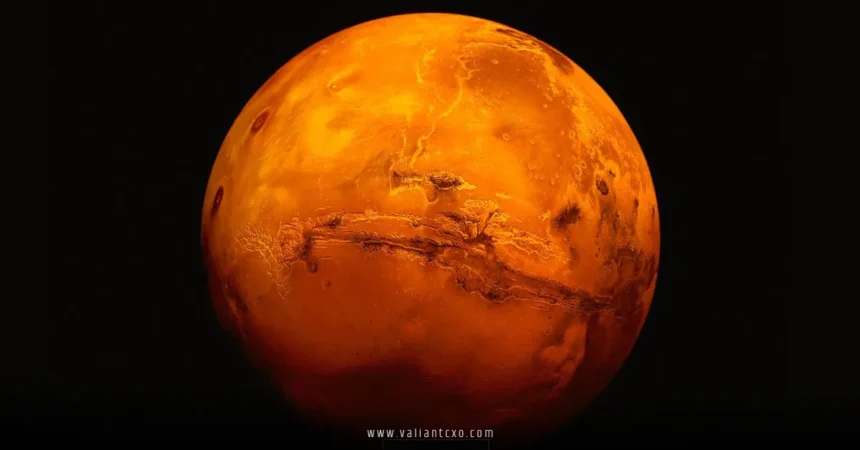Mars has always been a cosmic tease, hasn’t it? That rusty-red dot in the night sky, glowing with secrets, has captured human imagination for centuries. From ancient myths to modern-day missions, Mars is more than just a planet—it’s a symbol of adventure, mystery, and the tantalizing possibility of life beyond Earth. Why does Marskeep us hooked? Maybe it’s the rugged canyons, towering volcanoes, or the dream of humans one day walking its dusty trails. In this deep dive, we’ll explore Mars from every angle—its history, geology, exploration, and what it means for humanity’s future. Buckle up for a journey to the Red Planet!
What Makes Mars So Special?
Mars isn’t just another rock in space. It’s the fourth planet from the Sun, roughly half the size of Earth, with a diameter of about 6,792 kilometers. Its reddish hue, caused by iron oxide (aka rust) on its surface, gives it that iconic look. But what really sets Mars apart is how eerily familiar it feels. Picture this: vast deserts, polar ice caps, and a day that’s just 40 minutes longer than ours. Sounds like Earth’s distant cousin, right? Yet, Mars is a wild, alien world with its own quirks and mysteries.
Why do we care so much? For one, Mar’s might hold clues about life beyond Earth. Scientists think it once had liquid water—maybe even oceans! That’s a big deal when you’re hunting for signs of ancient microbes or dreaming of future colonies. Plus, Mar’s is our best bet for human exploration. It’s close enough to reach (a mere six-month trip) but alien enough to feel like stepping into a sci-fi flick.
A Quick Look at Mars Vital Stats
- Diameter: ~6,792 km (about half of Earth’s)
- Day Length: 24.6 hours (a Martian “sol”)
- Year Length: 687 Earth days
- Surface Temperature: -140°C to 20°C (-220°F to 68°F)
- Atmosphere: Thin, mostly carbon dioxide
- Moons: Two—Phobos and Deimos
These stats paint a picture of a harsh but intriguing world. Mar’s is cold, dusty, and airless by human standards, but its features—like the solar system’s largest volcano and canyon—make it a geological wonderland.
The Geology of Mars: A Landscape of Extremes
If mar’s were a painting, it’d be a masterpiece of bold contrasts. Its surface is a mix of sprawling deserts, towering mountains, and craters that tell stories of cosmic collisions. Let’s break down the Red Planet’s most jaw-dropping features.
Olympus Mons: The King of Volcanoes
Imagine a volcano so massive it makes Mount Everest look like a hill. That’s Olympus Mons, the largest volcano in the solar system. Standing at 22 kilometers (13.6 miles) tall, it’s nearly three times taller than Everest. Why so big? mar’s lacks plate tectonics, so lava just piled up over millions of years, creating this monstrous peak. If you stood on its summit, you’d feel like you were touching the edge of space.
Valles Marineris: The Grand Canyon of mar’s
Then there’s Valles Marineris, a canyon system that stretches over 4,000 kilometers (2,500 miles)—long enough to span the United States! It’s up to 11 kilometers deep in places, dwarfing Earth’s Grand Canyon. This massive scar on [mars]’s surface likely formed from a combination of rifting and erosion. Can you imagine hiking its cliffs? You’d need a spacesuit and some serious courage.
Polar Ice Caps and Ancient Rivers
Mar’s has ice caps at both poles, made of water and carbon dioxide ice. These caps grow and shrink with the Martian seasons, just like Earth’s. But the real kicker? Evidence of ancient riverbeds and lakebeds suggests Mar’s once had flowing water. Satellites have spotted dry channels and mineral deposits that scream “water was here!” Could these be hints of a wetter, warmer Mar’s long ago?
The Search for Life on [mars]
Here’s the million-dollar question: Has Mar’s ever hosted life? Scientists are obsessed with this idea, and for good reason. The planet’s past seems to check all the boxes for life as we know it—water, energy, and organic molecules. Let’s dive into why Mar’s is the ultimate treasure hunt for astrobiologists.
Clues from Water and Methane
Water is life’s best friend, and Mar’s has plenty of it—frozen, at least. Rovers like Curiosity have found evidence of ancient lakes and rivers, while underground ice deposits hint at hidden reservoirs. In 2018, scientists even detected a possible liquid lake under the south pole. A lake on Mar’s! That’s the kind of discovery that makes you sit up straight.
Then there’s methane. This gas, often produced by living organisms on Earth, has been detected in Mar’s atmosphere. It comes and goes, which is puzzling. Is it from microbes? Volcanoes? Or something else entirely? The jury’s still out, but every whiff of methane fuels the dream of finding Martian life.
Rovers and Their Discoveries
NASA’s rovers—Curiosity, Perseverance, and others—have been Mar’s tireless detectives. Curiosity, for example, found organic molecules in Martian soil, the building blocks of life. Perseverance, launched in 2020, is collecting rock samples that might contain fossilized microbes. These samples will eventually come back to Earth for analysis, thanks to a joint NASA-ESA mission. Imagine holding a piece of [mars] in your hands!
Fun Fact: Perseverance’s landing site, Jezero Crater, was chosen because it’s a dried-up lakebed. If life ever existed on [mars], this is a prime spot to find it.
Human Exploration of Mars’s: Are We There Yet?
Dreaming of humans on Mar’s isn’t just sci-fi anymore—it’s a real goal. But getting there? That’s like trying to climb Everest in flip-flops. The challenges are massive, but so is the ambition. Let’s unpack what it’ll take to put boots on Mar’s.
The Journey to mar’s
A trip to Mar’s takes about six months with current tech. Rockets like SpaceX’s Starship or NASA’s SLS are designed to make this journey possible. But space is no picnic. Astronauts face cosmic radiation, zero gravity, and the psychological toll of being stuck in a tin can for half a year. Once they land, Mars’s thin atmosphere and brutal cold (-140°C!) make survival tricky.
Living on Mar’s
If we want to stay on Mar’s, we’ll need more than a tent. Scientists are exploring habitats like 3D-printed domes made from Martian soil or underground lava tubes for natural radiation shielding. Food? Water? Oxygen? We’d need to grow crops in greenhouses, recycle water, and extract oxygen from Mars CO2-heavy air. It’s like setting up a mini-Earth in the middle of a cosmic desert.
Pro Tip: Check out NASA’s Mars Exploration Program for the latest on how we’re planning to conquer these challenges.
Elon Musk’s Big Mars Dream
Elon Musk, the guy behind SpaceX, wants to make Marsa second home for humanity. His Starship rocket is designed to carry dozens of people and tons of cargo to Mar’s. Musk’s vision? A self-sustaining colony by 2050. Bold? Absolutely. Crazy? Maybe not. SpaceX is already testing Starship prototypes, and each success brings Mar’s a little closer.
Mars in Pop Culture: From Books to Blockbusters
Mar’s isn’t just a planet—it’s a cultural icon. From H.G. Wells’ War of the Worlds to The Martian starring Matt Damon, Mar’s has inspired countless stories. Why? It’s the perfect backdrop for tales of adventure, survival, and alien encounters. In The Martian, Mark Watney’s struggle to survive on Mar’s feels so real because it’s grounded in science. Stranded astronaut, potato farming, and duct tape fixes? That’s Mars’ in all its gritty glory.
Movies aren’t the only ones obsessed. Video games like Doom and Surviving Mar’s let you battle demons or build colonies on the Red Planet. Even music gets in on the action—think David Bowie’s “Life on Mar’s?” It’s like Mar’s is a muse for human creativity.
The Future of Mars: What’s Next?
So, where’s Mars headed? The next decade is packed with exciting missions. China’s Tianwen-1 rover is already exploring, while Europe’s ExoMars rover will hunt for life signs. Private companies like SpaceX are pushing the envelope, and NASA’s Artemis program (focused on the Moon) is a stepping stone to Mars. By the 2030s, we might see humans take their first steps on the Red Planet.
But Mars isn’t just about science—it’s about us. It’s about pushing boundaries, chasing dreams, and asking, “What’s possible?” Whether it’s finding ancient microbes or building a Martian city, Mars challenges us to think bigger.
Want to Stay Updated? Follow SpaceX’s Mars Mission Updates for the latest on humanity’s Red Planet ambitions.
Conclusion: Why Mar’s Matters
Mar’s is more than a distant planet—it’s a mirror reflecting our curiosity, ingenuity, and dreams. From its towering volcanoes to its ancient riverbeds, Mar’s tells a story of a world that might have been like ours once. Every rover, every discovery, every wild idea about colonizing Mar’s brings us closer to understanding our place in the universe. So, keep looking up, keep wondering, and maybe one day, you’ll be part of the story of Mar’s. What’s stopping you from joining the adventure?
FAQs About Mars
1. Why is Mars called the Red Planet?
Mars gets its nickname from its reddish appearance, caused by iron oxide (rust) on its surface. The iron-rich dust gives [mars] that iconic rusty glow, especially when viewed from Earth.
2. Has [mars] ever had liquid water?
Yes! Evidence from rovers and orbiters shows [mars] had liquid water billions of years ago, with rivers, lakes, and possibly oceans. Today, water exists mostly as ice or in possible underground lakes.
3. Can humans live on Mars in the future?
Living on Mars is possible but tough. We’d need habitats to shield us from radiation, systems to produce food and oxygen, and ways to handle the cold. Companies like SpaceX are working on making this a reality.
4. What’s the biggest challenge of exploring mars?
The biggest hurdle is Mars’s harsh environment—thin atmosphere, extreme cold, and radiation. Getting there and back safely, plus sustaining human life, requires cutting-edge tech and big budgets.
5. How can I learn more about Mars missions?
Check out ESA’s Mars Exploration Page for updates on global missions. NASA and SpaceX also share regular news about Mars exploration.
For More Updates !! : valiantcxo.com


